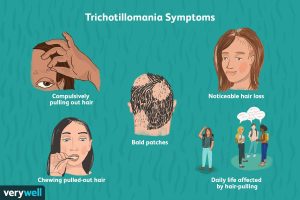- 25 January 2024
- 374
Pulling Hair? Let’s Talk about Trichotillomania in Simple Terms
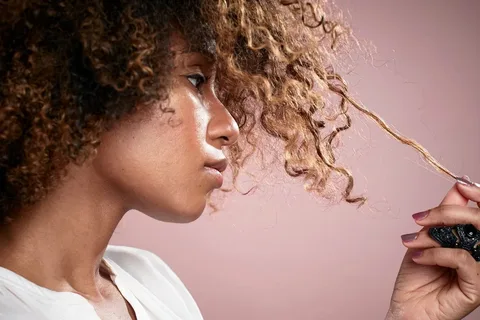
Introduction
Trichotillomania, often referred to as TTM, stands as a compelling yet challenging impulse control disorder characterized by the relentless urge to pull out one’s hair. This article endeavors to delve into the intricate facets of this hairpulling disorder, unraveling its causes, symptoms, available treatments, and potential complications.
What Is Trichotillomania?
Trichotillomania manifests as a compelling compulsion to pull out hair, predominantly from the scalp, eyelashes, and eyebrows. Mental health professionals categorize it as a “body-focused repetitive behavior,” wherein seemingly innocuous habits like hairpulling transform into extreme patterns, impeding the individual’s ability to derive joy from life.
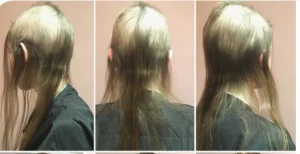
How Common is Trichotillomania?
The prevalence of trichotillomania remains elusive, primarily due to underreporting fueled by societal stigma. While an estimated 3.5% of individuals may experience bouts of hairpulling at some point, the actual figures might be higher. Trichotillomania often precipitates emotional distress, leading individuals to withdraw from social engagements.
Why Does Pulling Hair Feel Good?
For many grappling with trichotillomania, the act of hairpulling becomes a coping mechanism, offering solace and a semblance of control amidst stress, frustration, or boredom. The brain’s release of “reward” chemicals, such as dopamine, reinforces the habit, creating a cycle of compulsion and momentary relief. Rituals and sensory experiences further entrench the behavior.
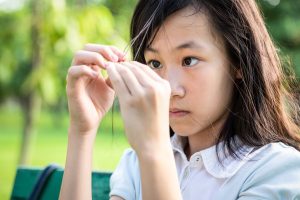
Symptoms
Causes
- Impulse Control Issues: Trichotillomania is often associated with difficulties in controlling impulses, leading to repetitive hairpulling.
- Brain Function: Research suggests a potential link between trichotillomania and variations in brain areas related to impulse control, learning, emotion, and movement.
- Genetic Factors: Familial tendencies indicate a higher likelihood of developing trichotillomania if other family members have the disorder.
- Gender Influence: While trichotillomania can affect individuals of any gender, adult women are up to nine times more likely to be diagnosed, possibly due to reporting patterns or hormonal influences.
- Other Mental Health Disorders: Trichotillomania often coexists with other mental health conditions, including anxiety, depression, or obsessive-compulsive disorder (OCD).
- Stress Triggers: Extreme stress, stemming from various sources like family conflicts or trauma, can act as a trigger for the onset or exacerbation of trichotillomania.
- Boredom: Some individuals may initiate hairpulling as a coping mechanism for boredom, gradually turning it into a habit.
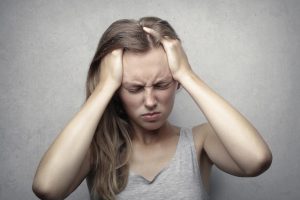
Diagnosis
Diagnosing trichotillomania involves a thorough evaluation of symptoms, ruling out other potential causes. The Diagnostic and Statistical Manual of Mental Disorders, Fifth Edition (DSM-5), provides criteria, emphasizing aspects like the inability to resist pulling, resultant distress, and the absence of alternative causes.
Treatment
Addressing trichotillomania necessitates a multifaceted approach. Therapeutic interventions, including acceptance and commitment therapy, habit reversal, and cognitive therapy, prove effective. Medications such as antidepressants may complement treatment. Self-care strategies involve distractions, stress management, and adopting alternative routines.
Complications
Left untreated, trichotillomania can lead to a myriad of complications, encompassing emotional distress, hindrances in work or social spheres, damage to the scalp, skin, or hair, and complications arising from the ingestion of pulled hair (trichophagia). This section underscores the imperative of seeking professional help to mitigate potential complications.

Trichotillomania and Eyebrows/Eyelashes
A specific exploration into the impact of trichotillomania on eyebrows and eyelashes unveils unique challenges. Preventive measures, potential complications, and diverse treatment options, including vitamins and medications, are discussed in detail.
Prevention
While a definitive prevention method remains elusive, early intervention and stress management emerge as pivotal in reducing symptoms. This section emphasizes the significance of prompt action to address symptoms and curtail the potential progression of trichotillomania.
In conclusion, trichotillomania, with its intricate interplay of psychological and physiological factors, demands nuanced understanding and tailored interventions for effective management. Seeking professional help, coupled with the adoption of self-care strategies, constitutes vital steps towards the path of recovery from this complex hairpulling disorder.


